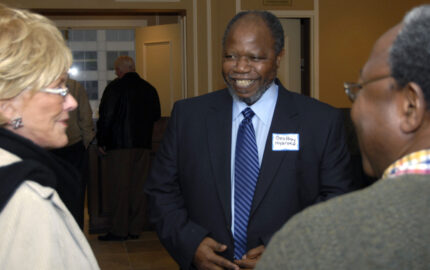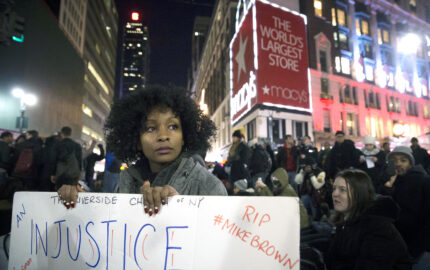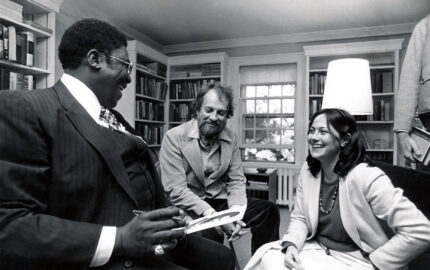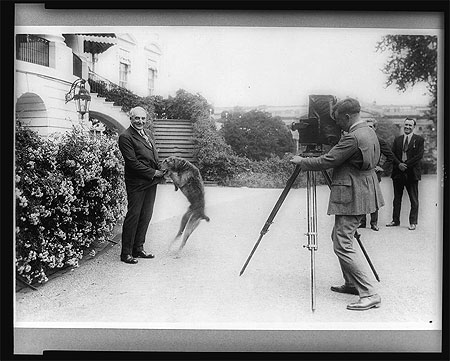
President Warren G. Harding being photographed in front of the White House with his dog, Laddie. 1922. Photo courtesy of the National Photo Company/Library of Congress Prints and Photographs Division.
“Sasha and Malia, I love you both more than you can imagine. And you have earned the new puppy that’s coming with us to the new White House.”
With those two sentences last November, Barack Obama, in his first moments as President-elect, thrilled animal lovers nearly as much as his victory thrilled anyone who appreciated the historic significance of an African-American winning the nation’s highest office. The Internet exploded with speculation. What kind of puppy? Purebred or mix? Rescue, pound or purchase? Given that two-thirds of U.S. households include at least one pet, it wasn’t surprising.
Interviewers couldn’t wait to dispense with weighty issues like war and recession so they could be first to answer the questions on millions of pet-keeping Americans’ minds. Obama dropped a few hints in his first press conference, noting Malia’s allergies—and his own biracial makeup: “There are a number of breeds that are hypoallergenic, but on the other hand our preference is to get a shelter dog, but obviously, a lot of the shelter dogs are mutts like me,” Obama said. “So, whether we are going to be able to balance those two things I think is a pressing issue on the Obama household.” But he said the family would wait until spring to get a dog—after they’d settled in.
Speculation escalated to advice—and to opportunities to increase reader/viewer interest by offering avenues for giving it. Bloggers and mainstream media outlets, grasping the passion that the nation’s nearly 400-million house pets inspire, launched breed selection and naming contests.
My newspaper, The Miami Herald, was among them, losing no time in soliciting ideas from readers. We ran a short announcement every day for a couple of weeks in the paper, as well as on my blog, Crazy for Critters, and got nearly 400 e-mailed responses. We ran a selection of photos and responses on the features front in early February and posted every picture—about 130—and all 400 e-mails at MiamiHerald.com. If the name of the media game these days is bringing eyeballs to the page, anything involving animals is a sure thing.
By then, the Obamas seemed to have narrowed down their choices to a Labradoodle—a Labrador/poodle mix—or a Portuguese water dog, both having the kind of hair that’s easier for someone with allergies to tolerate than most dogs’ fur. Aficionados of both types began lobbying anew, providing another opportunity to revisit one of the year’s few feel-good stories. (On February 25th, Michelle Obama disclosed that the kids would get their pet after spring break in April and, more than likely, it would be a “Porti,” as the water dogs are called. She told People magazine that the family hoped to find one through a rescue group—though at press time, the bloggers at labradoodlesforobama.com were reporting that “doodles” were still in the running).
Why such interest? Pets are hardly a White House novelty. But this was the first time that Americans felt as though they had some say in the choice—an empowering notion for an electorate that had just made history.
The vacating first family, George W. Bush’s, kept three dogs and a cat. The Clintons before them had a dog and a cat, Socks, whose death at 19 The Associated Press reported on February 20th.
Historians believe that all but four presidents since George Washington have kept animals on the official residence’s grounds: a diverse menagerie that has included horses, cows, sheep, barnyard fowl, swine, snakes, rodents, tropical birds, fish—even elephants—in addition to scores of dogs and cats.
The petless four: Millard Fillmore, Chester A. Arthur, Franklin Pierce, and James K. Polk. Technically, Martin Van Buren (1837-1841) was also petless; he accepted a pair of tiger cubs from the Sultan of Oman but sent them to live at a zoo.
Surely the most exotic critters came with the John Quincy Adams administration (1825-1829): an alligator that the Marquise de Lafayette bestowed on the President and silkworms that first lady Louisa Adams kept. James Buchanan (1857-1861) had the elephants, a gift from the King of Siam.
It could be argued that with financial markets in a death spiral and armed conflict raging across the globe, news organizations—themselves in dire circumstances—ought to be focused on the stories that affect the lives of Americans struggling to stay in their homes and keep their jobs. But presidential pets have long been in the news, sometimes as unwitting props, sometimes as political symbols, sometimes because they make news on their own. On November 6th, two days after Obama’s election, Barney, a Bush family Scottish terrier, bit the outstretched hand of Jon Decker, a Reuters political reporter, at the White House. Given the outgoing administration’s relationship with the press, pundits and late-night comics drew the obvious analogy.
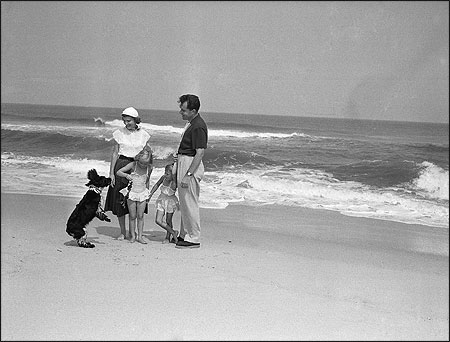
Then Vice President Richard M. Nixon and his family with their dog Checkers on the beach in Mantoloking, New Jersey. Photo courtesy of The Associated Press.
It wasn’t the first time that a first pet seemed to speak for—or volumes about—his or her master in chief. In 1952, Republican Vice Presidential candidate Richard M. Nixon was accused of accepting $18,000 in illegal gifts. Perhaps foreshadowing the corruption that would end his presidency decades later, he denied the allegations—except for the cocker spaniel puppy that a supporter had given his two daughters.
In the smarmy combination of self-pity and defiance that became a Nixon hallmark, he declared that his daughters, “like all kids, love the dog, and I just want to say this right now, that regardless of what they say about it, we’re gonna keep it.”
-large.sub.jpg)
President Lyndon B. Johnson holds up his beagle, Him, by the ears as members of the press look on. 1964. Photo by Cecil Stoughton/Courtesy of the Lyndon Baines Johnson Library and Museum.
Lyndon Johnson outraged dog lovers when he hoisted a beagle named Him—whose mate was named Her—by the ears in 1964 on the White House lawn. But the gesture seemed an apt metaphor for Johnson’s manhandling political methods.
Perhaps the most famous pet reference by a U.S. President was Harry S. Truman’s rueful maxim, “If you want a friend in Washington, get a dog.’’ It was advice that the President—deeply unpopular for much of his two terms, 1945-1953—didn’t follow. In 1947, he received Feller, a cocker spaniel, as a gift. According to the Presidential Pet Museum, he passed the pup on to his physician, who became the first of eight masters to keep the hapless canine, until he found a home at last on a farm, where he died of old age.
Given Barack Obama’s sky-high approval ratings, it’s not likely he’ll need Truman’s advice, either. Given his political savvy, he also knows that the campaign promise he made to his daughters is one he dare not break.
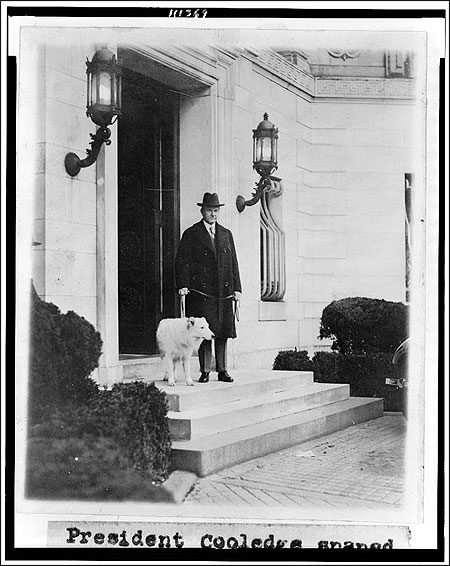
President Calvin Coolidge with one of his family’s dogs. 1927. Photo courtesy of the National Photo Company/Library of Congress Prints and Photographs Division.
Elinor J. Brecher, a 1988 Nieman Fellow, is The Miami Herald’s obituary writer and the author of Crazy for Critters, the Herald’s pet blog. She was accompanied on her Nieman Fellowship by her dog Harpo, a collie/golden retriever mix.

